
- Details
- By Chez Oxendine
- Food | Agriculture
A pair of federal grants totaling nearly $8 million should allow the Coquille Tribe to improve conditions for both fish and people in southwest Oregon's Coquille River Watershed.
The tribe received two grants this month through the National Oceanic and Atmospheric Administration (NOAA): the $4.2 million Barrier Removal Grant and a $3.6 million Pacific Coast Salmon Recovery Fund Grant.
The barrier removal grant will allow the tribe to repair two failing culverts and three failing tide gates along the Coquille River, improving both passage for fish and the safety of roads for drivers over the culverts.
The salmon recovery grant will allow the tribe to employ natural solutions — such as willow mattresses, boulders, and logs — to slow erosion along the river’s banks. In years past, erosion has destroyed vegetation, carved away land needed for agriculture, and disrupted salmon spawning. The project will target 1,200 feet along the riverbank, where erosion has carved cliffs into the stream sides that can reach 30 or 40 feet into the banks, according to Coquille Natural Resources Director John Ogen.
“We've developed nature-based solutions where we can come in and put some structures in the river and along the streambank — all engineered to capture downstream sediments and rebuild this little floodplain,” Ogen told Tribal Business News. “The tribe is very much featuring this nature-based solution so the river can begin to heal itself.”
That project will be developed with the support of a private landowner, who is allowing access to the land where the solutions will be deployed. If successful, the solution could open the door to similar projects along the river, encouraging private landowners to allow the tribe onto their land to do the work, Ogen said.
The current site is similar to “three to four dozen” throughout the Coquille Watershed, according to Ogden, who is excited to use it as a demonstration site to show private landowners how natural solutions can restore what he calls “some of the best agricultural land in the watershed.”
“Working with private landowners just requires being very transparent and listening to their ideas as well as concerns,” Ogden said. “Invariably, they want to see salmon abundance restored and have healthy waters. We have to earn trust that we aren’t going to try to erode their property rights or impact their operations in a negative way.”
Helena Linnell, the Coquille Tribe’s environmental biologist and planner, said the work represented an “exciting opportunity” to work with new partners on habitat restoration, which in turn would help “balance” the land’s ability to support both agriculture and fish migration.
“The goal of these grants is to add more complexity into our watershed to provide a balance of current use,” Linnell said. “While it can take some time to see those positive effects, it will ultimately lead to the positive changes that will have the most lasting effects on fish populations, on water quality, and ecosystem abundance.”
The barrier removal project will allow the Coquille tribe to repair two culverts and three tide gates that have all fallen into disrepair throughout the watershed. The repairs will improve the roads on which the culverts sit, and better protect the agricultural lands the tide gates are meant to guard.
Most importantly, however, the repairs will improve the ability for fish to pass through the gates and culverts. That increased access should help salmon reach spawning grounds, Ogen said.
The goal behind both of the grants, Ogen said, was to restore dwindling salmon, lamprey, and steelhead populations — a task the tribe considers important both economically and culturally.
“The tribal council has talked about their sense of obligation to steward salmon and their habitat. It’s really part of how the tribe defines themselves,” Ogen, who is not an enrolled tribal member, said. “Salmon, lamprey — these are the DNA of the Coquille people. They consider themselves to be constituted from these bountiful resources, and so it’s our sacred obligation to steward them.”
NOAA West Coast Public Affairs Officer Michael Milstein said the agency hopes the Coquille projects will become models for landowners and other projects in the Coquille River Basin.
“We're proud to support the tribe's work to improve habitat for salmon and steelhead along the Oregon Coast at a time when it can make a real difference for the species and all who depend on them,” Milstein wrote in an email to Tribal Business News. “Climate change is altering the landscape and improvements such as removing barriers and restoring streamside habitat can improve their resilience and survival.”
